| Insects Temporal range: 396–0 Ma Early Devonian[1] (but see text) – Recent | |
|---|---|
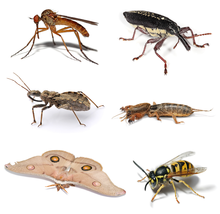 | |
| Clockwise from top left: dancefly (Empis livida), long-nosed weevil (Rhinotia hemistictus), mole cricket (Gryllotalpa brachyptera), German wasp (Vespula germanica), emperor gum moth (Opodiphthera eucalypti), assassin bug (Harpactorinae) | |
| Scientific classification [ e ] | |
| Kingdom: | Animalia |
| Phylum: | Arthropoda |
| Subphylum: | Hexapoda |
| Class: | Insecta Linnaeus, 1758 |
| Subclasses | |
The life cycles of insects vary but most hatch from eggs. Insect growth is constrained by the inelastic exoskeleton and development involves a series of molts. The immature stages can differ from the adults in structure, habit and habitat and can include a passive pupal stage in those groups that undergo complete metamorphosis. Insects that undergo incomplete metamorphosis lack a pupal stage and adults develop through a series of nymphal stages.[7] The higher level relationship of the hexapoda is unclear. Fossilized insects of enormous size have been found from the Paleozoic Era, including giant dragonflies with wingspans of 55 to 70 cm (22–28 in). The most diverse insect groups appear to have coevolved with flowering plants.
Insects typically move about by walking, flying or occasionally swimming. Because it allows for rapid yet stable movement, many insects adopt a tripedal gait in which they walk with their legs touching the ground in alternating triangles. Insects are the only invertebrates to have evolved flight. Many insects spend at least part of their life underwater, with larval adaptations that include gills and some adult insects are aquatic and have adaptations for swimming. Some species, like water striders, are capable of walking on the surface of water.
Insects are mostly solitary, but some insects, such as certain bees, ants, and termites are social and live in large, well-organized colonies. Some insects, like earwigs, show maternal care, guarding their eggs and young. Insects can communicate with each other in a variety of ways. Male moths can sense the pheromones of female moths over distances of many kilometers. Other species communicate with sounds: crickets stridulate, or rub their wings together, to attract a mate and repel other males. Lampyridae in the beetle order Coleoptera communicate with light.
Humans regard certain insects as pests and attempt to control them using insecticides and a host of other techniques. Some insects damage crops by feeding on sap, leaves or fruits, a few bite humans and livestock, alive and dead, to feed on blood and some are capable of transmitting diseases to humans, pets and livestock. Many other insects are considered ecologically beneficial and a few provide direct economic benefit. Silkworms and bees have been domesticated by humans for the production of silk and honey, respectively.
Contents |
Morphology and physiology
Main articles: Insect morphology and Insect physiology
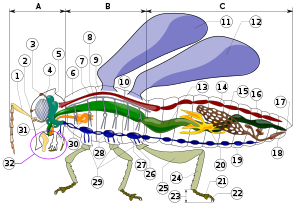
Insect morphology
A- Head B- Thorax C- Abdomen
A- Head B- Thorax C- Abdomen
1. antenna
2. ocelli (lower)
3. ocelli (upper)
4. compound eye
5. brain (cerebral ganglia)
6. prothorax
7. dorsal blood vessel
8. tracheal tubes (trunk with spiracle)
9. mesothorax
10. metathorax
11. forewing
12. hindwing
13. mid-gut (stomach)
14. dorsal tube (Heart)
15. ovary
16. hind-gut (intestine, rectum & anus)
17. anus
18. oviduct
19. nerve chord (abdominal ganglia)
20. Malpighian tubes
21. tarsal pads
22. claws
23. tarsus
24. tibia
25. femur
26. trochanter
27. fore-gut (crop, gizzard)
28. thoracic ganglion
29. coxa
30. salivary gland
31. subesophageal ganglion
32. mouthparts
.2. ocelli (lower)
3. ocelli (upper)
4. compound eye
5. brain (cerebral ganglia)
6. prothorax
7. dorsal blood vessel
8. tracheal tubes (trunk with spiracle)
9. mesothorax
10. metathorax
11. forewing
12. hindwing
13. mid-gut (stomach)
14. dorsal tube (Heart)
15. ovary
16. hind-gut (intestine, rectum & anus)
17. anus
18. oviduct
19. nerve chord (abdominal ganglia)
20. Malpighian tubes
21. tarsal pads
22. claws
23. tarsus
24. tibia
25. femur
26. trochanter
27. fore-gut (crop, gizzard)
28. thoracic ganglion
29. coxa
30. salivary gland
31. subesophageal ganglion
32. mouthparts
General body plan
Insects have segmented bodies supported by an exoskeleton, a hard outer covering made mostly of chitin. The segments of the body are organized into three distinctive but interconnected units, or tagmata: a head, a thorax, and an abdomen.[8] The head supports a pair of sensory antennae, a pair of compound eyes, and, if present, one to three simple eyes (or ocelli) and three sets of variously modified appendages that form the mouthparts. The thorax has six segmented legs—one pair each for the prothorax, mesothorax and the metathorax segments making up the thorax—and, if present in the species, two or four wings. The abdomen consists of eleven segments, though in a few species of insects these segments may be fused together or reduced in size. The abdomen also contains most of the digestive, respiratory, excretory and reproductive internal structures.[9]:22–48 There is considerable variation and many adaptations in the body parts of insects especially wings, legs, antenna, mouth-parts etc.Exoskeleton
Insect outer skeleton, the cuticle, is made up of two layers: the epicuticle, which is a thin and waxy water resistant outer layer and contains no chitin, and a lower layer called the procuticle. The procuticle is chitinous and much thicker than the epicuticle and has two layers: an outer layer known as the exocuticle and an inner layer known as the endocuticle. The tough and flexible endocuticle is built from numerous layers of fibrous chitin and proteins, criss-crossing each others in a sandwich pattern, while the exocuticle is rigid and hardened.[9]:22–24 The exocuticle is greatly reduced in many soft-bodied insects (e.g., caterpillars), especially during their larval stages.Insects are the only invertebrates to have developed active flight capability, and this has played an important role in their success.[9]:186 These muscles are able to contract multiple times for each single nerve impulse, allowing the wings to beat faster than would ordinarily be possible. Having their muscles attached to their exoskeletons is more efficient and allows more muscle connections; crustaceans also use the same method, though all spiders use hydraulic pressure to extend their legs, a system inherited from their pre-arthropod ancestors. Unlike insects, though, most aquatic crustaceans are biomineralized with calcium carbonate extracted from the water.[10][11]
Nervous system
The nervous system of an insect can be divided into a brain and a ventral nerve cord. The head capsule is made up of six fused segments, each with a pair of ganglia, or a cluster of nerve cells outside of the brain. The first three pairs of ganglia are fused into the brain, while the three following pairs are fused into a structure of three pairs of ganglia under the insect's esophagus, called the subesophageal ganglion.[9]:57The thoracic segments have one ganglion on each side, which are connected into a pair, one pair per segment. This arrangement is also seen in the abdomen but only in the first eight segments. Many species of insects have reduced numbers of ganglia due to fusion or reduction.[12] Some cockroaches have just six ganglia in the abdomen, whereas the wasp Vespa crabro has only two in the thorax and three in the abdomen. Some insects, like the house fly Musca domestica, have all the body ganglia fused into a single large thoracic ganglion.
At least a few insects have nociceptors, cells that detect and transmit sensations of pain.[13] This was discovered in 2003 by studying the variation in reactions of larvae of the common fruitfly Drosophila to the touch of a heated probe and an unheated one. The larvae reacted to the touch of the heated probe with a stereotypical rolling behavior that was not exhibited when the larvae were touched by the unheated probe.[14] Although nociception has been demonstrated in insects, there is not a consensus that insects feel pain consciously.[15]
Digestive system
An insect uses its digestive system to extract nutrients and other substances from the food it consumes.[16] Most of this food is ingested in the form of macromolecules and other complex substances like proteins, polysaccharides, fats, and nucleic acids. These macromolecules must be broken down by catabolic reactions into smaller molecules like amino acids and simple sugars before being used by cells of the body for energy, growth, or reproduction. This break-down process is known as digestion.The main structure of an insect's digestive system is a long enclosed tube called the alimentary canal, which runs lengthwise through the body. The alimentary canal directs food unidirectionally from the mouth to the anus. It has three sections, each of which performs a different process of digestion. In addition to the alimentary canal, insects also have paired salivary glands and salivary reservoirs. These structures usually reside in the thorax, adjacent to the foregut.[9]:70–77
The salivary glands (element 30 in numbered diagram) in an insect's mouth produce saliva. The salivary ducts lead from the glands to the reservoirs and then forward through the head to an opening called the salivarium, located behind the hypopharynx. By moving its mouthparts (element 32 in numbered diagram) the insect can mix its food with saliva. The mixture of saliva and food then travels through the salivary tubes into the mouth, where it begins to break down.[16][17] Some insects, like flies, have extra-oral digestion. Insects using extra-oral digestion expel digestive enzymes onto their food to break it down. This strategy allows insects to extract a significant proportion of the available nutrients from the food source.[18]:31 The gut is where almost all of insects' digestion takes place. It can be divided into the foregut, midgut and hindgut.
Foregut

Stylized diagram of insect digestive tract showing malpighian tubule, from an insect of the order Orthoptera.
From there, the pharynx passes food to the esophagus, which could be just a simple tube passing it on to the crop and proventriculus, and then on ward to the midgut, as in most insects. Alternately, the foregut may expand into a very enlarged crop and proventriculus, or the crop could just be a diverticulum, or fluid filled structure, as in some Diptera species.[18]:30–31
Midgut
Once food leaves the crop, it passes to the midgut (element 13 in numbered diagram), also known as the mesenteron, where the majority of digestion takes place. Microscopic projections from the midgut wall, called microvilli, increase the surface area of the wall and allow more nutrients to be absorbed; they tend to be close to the origin of the midgut. In some insects, the role of the microvilli and where they are located may vary. For example, specialized microvilli producing digestive enzymes may more likely be near the end of the midgut, and absorption near the origin or beginning of the midgut.[18]:32Hindgut
In the hindgut (element 16 in numbered diagram), or proctodaeum, undigested food particles are joined by uric acid to form fecal pellets. The rectum absorbs 90% of the water in these fecal pellets, and the dry pellet is then eliminated through the anus (element 17), completing the process of digestion. The uric acid is formed using hemolymph waste products diffused from the Malpighian tubules (element 20). It is then emptied directly into the alimentary canal, at the junction between the midgut and hindgut. The number of Malpighian tubules possessed by a given insect varies between species, ranging from only two tubules in some insects to over 100 tubules in others.[9]:71–72, 78–80Respiration and circulation
Insect respiration is accomplished without lungs. Instead, the insect respiratory system uses a system of internal tubes and sacs through which gases either diffuse or are actively pumped, delivering oxygen directly to tissues that need it via their trachea (element 8 in numbered diagram). Since oxygen is delivered directly, the circulatory system is not used to carry oxygen, and is therefore greatly reduced. The insect circulatory system has no veins or arteries, and instead consists of little more than a single, perforated dorsal tube which pulses peristaltically. Toward the thorax, the dorsal tube (element 14) divides into chambers and acts like the insect's heart. The opposite end of the dorsal tube is like the aorta of the insect circulating the hemolymph, arthropods' fluid analog of blood, inside the body cavity.[9]:61–65[19] Air is taken in through openings on the sides of the abdomen called spiracles.There are many different patterns of gas exchange demonstrated by different groups of insects. Gas exchange patterns in insects can range from continuous and diffusive ventilation, to discontinuous gas exchange.[9]:65–68 During continuous gas exchange, oxygen is taken in and carbon dioxide is released in a continuous cycle. In discontinuous gas exchange, however, the insect takes in oxygen while it is active and small amounts of carbon dioxide are released when the insect is at rest.[20] Diffusive ventilation is simply a form of continuous gas exchange that occurs by diffusion rather than physically taking in the oxygen. Some species of insect that are submerged also have adaptations to aid in respiration. As larvae, many insects have gills that can extract oxygen dissolved in water, while others need to rise to the water surface to replenish air supplies which may be held or trapped in special structures.[21][22]
Reproduction and development

A pair of Simosyrphus grandicornis hoverflies mating in flight.

The different forms of the male (top) and female (bottom) tussock moth Orgyia recens is an example of sexual dimorphism in insects.
Some insects use parthenogenesis, a process in which the female can reproduce and give birth without having the eggs fertilized by a male. Many aphids undergo a form of parthenogenesis, called cyclical parthenogenesis, in which they alternate between one or many generations of asexual and sexual reproduction.[24][25] In summer, aphids are generally female and parthenogenetic; in the autumn, males may be produced for sexual reproduction. Other insects produced by parthenogenesis are bees, wasps, and ants, in which they spawn males. However, overall, most individuals are female, which are produced by fertilization. The males are haploid and the females are diploid.[7] More rarely, some insects display hermaphroditism, in which a given individual has both male and female reproductive organs.
Insect life-histories show adaptations to withstand cold and dry conditions. Some temperate region insects are capable of activity during winter, while some others migrate to a warmer climate or go into a state of torpor.[26] Still other insects have evolved mechanisms of diapause that allow eggs or pupae to survive these conditions.[27]
Metamorphosis
Metamorphosis in insects is the biological process of development all insects must undergo. There are two forms of metamorphosis: incomplete metamorphosis and complete metamorphosis.Incomplete metamorphosis
Main article: Hemimetabolism
Insects that show hemimetabolism, or incomplete metamorphosis, change gradually by undergoing a series of molts. An insect molts when it outgrows its exoskeleton, which does not stretch and would otherwise restrict the insect's growth. The molting process begins as the insect's epidermis secretes a new epicuticle. After this new epicuticle is secreted, the epidermis releases a mixture of enzymes that digests the endocuticle and thus detaches the old cuticle. When this stage is complete, the insect makes its body swell by taking in a large quantity of water or air, which makes the old cuticle split along predefined weaknesses where the old exocuticle was thinnest.[9]:142[28] Other arthropods have a much different process and only molt; though must accommodate for the difference in exoskeleton structure and make up with other enzymes.Immature insects that go through incomplete metamorphosis are called nymphs or in the case of dragonflies and damselflies as naiads. Nymphs are similar in form to the adult except for the presence of wings, which are not developed until adulthood. With each molt, nymphs grow larger and become more similar in appearance to adult insects.
Like other insects that develop through incomplete metamorphosis, this Southern Hawker dragonfly molts its exoskeleton (shown above) several times during its pre-adult life.
Complete metamorphosis
Main article: Holometabolism
Holometabolism, or complete metamorphosis, is where the insect changes all in four stages, an egg or embryo, a larva, a pupa, and the adult or imago. In these species, egg hatches to produce a larva, which is generally worm-like in form. This worm-like form can be one of several varieties: eruciform (caterpillar-like), scarabaeiform (grub-like), campodeiform (elongated, flattened, and active), elateriform (wireworm-like) or vermiform (maggot-like). The larva grows and eventually becomes a pupa, a stage marked by reduced movement and often sealed within a cocoon. There are three types of pupae: obtect, exarate or coarctate. Obtect pupae are compact, with the legs and other appendages enclosed. Exarate pupae have their legs and other appendages free and extended. Coarctate pupae develop inside the larval skin.[9]:151 Insects undergo considerable change in form during the pupal stage, and emerge as adults. Butterflies are a well known example of an insects that undergo complete metamorphosis, although most insects use this life cycle. Some insects have evolved this system to hypermetamorphosis.Some of the oldest and most successful insect groups, such Endopterygota, use a system of complete metamorphosis.[9]:143 Strangely though, complete metamorphosis is unique to certain insect orders, like Diptera, Lepidoptera, and Hymenoptera, and no other arthropods undergo it, but incomplete metamorphosis.
Senses and communication
Many insects possess very sensitive and/or specialized organs of perception. Some insects such as bees can perceive ultraviolet wavelengths, or detect polarized light, while the antennae of male moths can detect the pheromones of female moths over distances of many kilometers.[29] There is a pronounced tendency for there to be a trade-off between visual acuity and chemical or tactile acuity, such that most insects with well-developed eyes have reduced or simple antennae, and vice-versa. There are a variety of different mechanisms by which insects perceive sound, while the patterns are not universal, insects can generally hear sound if they can produce it. Different insect species can have varying hearing, though most insects can hear only a narrow range of frequencies related to the frequency of the sounds they can produce. Mosquitoes have been found to hear up to 2 MHz., and some grasshoppers can hear up to 50 MHz.[30] Certain predatory and parasitic insects can detect the characteristic sounds made by their prey or hosts, respectively. For instance, some nocturnal moths can perceive the ultrasonic emissions of bats, which helps them avoid predation.[9]:87–94 Insects that feed on blood have special sensory structures that can detect infrared emissions, and use them to home in on their hosts.Some insects display a rudimentary sense of numbers,[31] such as the solitary wasps that prey upon a single species. The mother wasp lays her eggs in individual cells and provides each egg with a number of live caterpillars on which the young feed when hatched. Some species of wasp always provide five, others twelve, and others as high as twenty-four caterpillars per cell. The number of caterpillars is different among species, but always the same for each sex of larva. The male solitary wasp in the genus Eumenes is smaller than the female, so the mother of one species supplies him with only five caterpillars; the larger female receives ten caterpillars in her cell.
Light production and vision
A few insects, such as members of the families Poduridae and Onychiuridae (Collembola), Mycetophilidae (Diptera), and the beetle families Lampyridae, Phengodidae, Elateridae and Staphylinidae are bioluminescent. The most familiar group are the fireflies, beetles of the family Lampyridae. Some species are able to control this light generation to produce flashes. The function varies with some species using them to attract mates, while others use them to lure prey. Cave dwelling larvae of Arachnocampa (Mycetophilidae, Fungus gnats) glow to lure small flying insects into sticky strands of silk.[32] Some fireflies of the genus Photuris mimic the flashing of female Photinus species to attract males of that species, which are then captured and devoured.[33] The colors of emitted light vary from dull blue (Orfelia fultoni, Mycetophilidae) to the familiar greens and the rare reds (Phrixothrix tiemanni, Phengodidae).[34]Most insects, except some species of cave dwelling crickets, are able to perceive light and dark. Many species have acute vision capable of detecting minute movements. The eyes include simple eyes or ocelli as well as compound eyes of varying sizes. Many species are able to detect light in the infrared, ultraviolet and the visible light wavelengths. Color vision has been demonstrated in many species and phylogenetic analysis suggests that UV-green-blue trichromacy existed from at least the Devonian period between 416 and 359 million years ago.[35]
Sound production and hearing
Insects were the earliest organisms to produce and sense sounds. Insects make sounds mostly by mechanical action of appendages. In grasshoppers and crickets, this is achieved by stridulation. Cicadas make the loudest sounds among the insects by producing and amplifying sounds with special modifications to their body and musculature. The African cicada Brevisana brevis has been measured at 106.7 decibels at a distance of 50 cm (20 in).[36] Some insects, such as the hawk moths and Hedylid butterflies, can hear ultrasound and take evasive action when they sense that they have been detected by bats. Some moths produce ultrasonic clicks that were once thought to have a role in jamming bat echolocation. The ultrasonic clicks were subsequently found to be produced mostly by unpalatable moths to warn bats, just as warning colorations are used against predators that hunt by sight.[37] Some otherwise palatable moths have evolved to mimic these calls.[38]  | |
| Problems listening to this file? See media help. | |
Communication using surface-borne vibrational signals is more widespread among insects because of size constraints in producing air-borne sounds.[40] Insects cannot effectively produce low-frequency sounds, and high-frequency sounds tend to disperse more in a dense environment (such as foliage), so insects living in such environments communicate primarily using substrate-borne vibrations.[41] The mechanisms of production of vibrational signals are just as diverse as those for producing sound in insects.
Some species use vibrations for communicating within members of the same species, such as to attract mates as in the songs of the shield bug Nezara viridula.[42] Vibrations can also be used to communicate between entirely different species; lycaenid (gossamer-winged butterfly) caterpillars which are myrmecophilous (living in a mutualistic association with ants) communicate with ants in this way.[43] The Madagascar hissing cockroach has the ability to press air through its spiracles to make a hissing noise as a sign of aggression;[44] the Death's-head Hawkmoth makes a squeaking noise by forcing air out of their pharynx when agitated, which may also reduce aggressive worker honey bee behavior when the two are in close proximity.[45]
Chemical communication
In addition to the use of sound for communication, a wide range of insects have evolved chemical means for communication. These chemicals, termed semiochemicals, are often derived from plant metabolites include those meant to attract, repel and provide other kinds of information. Pheromones, a type of semiochemical, are used for attracting mates of the opposite sex, for aggregating conspecific individuals of both sexes, for deterring other individuals from approaching, to mark a trail, and to trigger aggression in nearby individuals. Allomonea benefit their producer by the effect they have upon the receiver. Kairomones benefit their receiver instead of their producer. Synomones benefit the producer and the receiver. While some chemicals are targeted at individuals of the same species, others are used for communication across species. The use of scents is especially well known to have developed in social insects.[9]:96–105Social behavior

A cathedral mound created by termites (Isoptera).
Only insects which live in nests or colonies demonstrate any true capacity for fine-scale spatial orientation or homing. This can allow an insect to return unerringly to a single hole a few millimeters in diameter among thousands of apparently identical holes clustered together, after a trip of up to several kilometers' distance. In a phenomenon known as philopatry, insects that hibernate have shown the ability to recall a specific location up to a year after last viewing the area of interest.[47] A few insects seasonally migrate large distances between different geographic regions (e.g., the overwintering areas of the Monarch butterfly).[9]:14
Care of young
Most insects lead short lives as adults, and rarely interact with one another except to mate or compete for mates. A small number exhibit some form of parental care, where they will at least guard their eggs, and sometimes continue guarding their offspring until adulthood, and possibly even feeding them. Another simple form of parental care is to construct a nest (a burrow or an actual construction, either of which may be simple or complex), store provisions in it, and lay an egg upon those provisions. The adult does not contact the growing offspring, but it nonetheless does provide food. This sort of care is typical of bees and various types of wasps.[48]Locomotion
Flight
Main article: Insect flight
Unlike birds, many small insects are swept along by the prevailing winds[52] although many of the larger insects are known to make migrations. Aphids are known to be transported long distances by low-level jet streams.[53] As such, fine line patterns associated with converging winds within weather radar imagery, like the WSR-88D radar network, often represent large groups of insects.[54]
Walking
Many adult insects use six legs for walking and have adopted a tripedal gait. The tripedal gait allows for rapid walking while always having a stable stance and has been studied extensively in cockroaches. The legs are used in alternate triangles touching the ground. For the first step, the middle right leg and the front and rear left legs are in contact with the ground and move the insect forward, while the front and rear right leg and the middle left leg are lifted and moved forward to a new position. When they touch the ground to form a new stable triangle the other legs can be lifted and brought forward in turn and so on.[55] The purest form of the tripedal gait is seen in insects moving at high speeds. However, this type of locomotion is not rigid and insects can adapt a variety of gaits. For example, when moving slowly, turning, or avoiding obstacles, four or more feet may be touching the ground. Insects can also adapt their gait to cope with the loss of one or more limbs.Cockroaches are among the fastest insect runners and, at full speed, adopt a bipedal run to reach a high velocity in proportion to their body size. As cockroaches move very quickly, they need to be video recorded at several hundred frames per second to reveal their gait. More sedate locomotion is seen in the stick insects or walking sticks (Phasmatodea). A few insects have evolved to walk on the surface of the water, especially the bugs of the Gerridae family, commonly known as water striders. A few species of ocean-skaters in the genus Halobates even live on the surface of open oceans, a habitat that has few insect species.[56]
Use in robotics
See also: Robot locomotion and Hexapod (robotics)
Insect walking is of particular interest as an alternative form of locomotion in robots. The study of insects and bipeds has a significant impact on possible robotic methods of transport. This may allow new robots to be designed that can traverse terrain that robots with wheels may be unable to handle.[55]Swimming
Main article: Aquatic insects
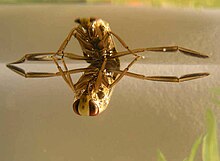
The backswimmer Notonecta glauca underwater, showing its paddle-like hindleg adaptation.
Many of these species have adaptations to help in under-water locomotion. Water beetles and water bugs have legs adapted into paddle-like structures. Dragonfly naiads use jet propulsion, forcibly expelling water out of their rectal chamber.[57] Some species like the water striders are capable of walking on the surface of water. They can do this because their claws are not at the tips of the legs as in most insects, but recessed in a special groove further up the leg; this prevents the claws from piercing the water's surface film.[21] Other insects such as the Rove beetle Stenus are known to emit pygidial gland secretions that reduce surface tension making it possible for them to move on the surface of water by Marangoni propulsion (also known by the German term Entspannungsschwimmen).[58][59]
Evolution

Evolution has produced astonishing variety in insects. Pictured are some of the possible shapes of antennae.
Main article: Evolution of insects
The evolutionary relationships of insects to other animal groups remain unclear. Although more traditionally grouped with millipedes and centipedes, evidence has emerged favoring closer evolutionary ties with crustaceans. In the Pancrustacea theory, insects, together with Remipedia and Malacostraca, make up a natural clade.[60] Other terrestrial arthropods, such as centipedes, millipedes, scorpions and spiders, are sometimes confused with insects since their body plans can appear similar, sharing (as do all arthropods) a jointed exoskeleton. However, upon closer examination their features differ significantly; most noticeably they do not have the six legs characteristic of adult insects.[61]
|
The origins of insect flight remain obscure, since the earliest winged insects currently known appear to have been capable fliers. Some extinct insects had an additional pair of winglets attaching to the first segment of the thorax, for a total of three pairs. As of 2009, there is no evidence that suggests that the insects were a particularly successful group of animals before they evolved to have wings.[65]
Late Carboniferous and Early Permian insect orders include both extant groups and a number of Paleozoic species, now extinct. During this era, some giant dragonfly-like forms reached wingspans of 55 to 70 cm (22 to 28 in) making them far larger than any living insect. This gigantism may have been due to higher atmospheric oxygen levels that allowed increased respiratory efficiency relative to today. The lack of flying vertebrates could have been another factor. Most extinct orders of insects developed during the Permian period that began around 270 million years ago. Many of the early groups became extinct during the Permian-Triassic extinction event, the largest mass extinction in the history of the Earth, around 252 million years ago.[66]
The remarkably successful Hymenopterans appeared as long as 146 million years ago in the Cretaceous period, but achieved their wide diversity more recently in the Cenozoic era, which began 66 million years ago. A number of highly successful insect groups evolved in conjunction with flowering plants, a powerful illustration of coevolution.[67]
Many modern insect genera developed during the Cenozoic. Insects from this period on are often found preserved in amber, often in perfect condition. The body plan, or morphology, of such specimens is thus easily compared with modern species. The study of fossilized insects is called paleoentomology.
Evolutionary relationships
Predation by vertebrates
Insects are prey for a variety of organisms, including terrestrial vertebrates. The earliest vertebrates on land existed 400 million years ago and were large amphibious piscivores, through gradual evolutionary change, insectivory was the next diet type to evolve.[68]Coevolution with plants
See also: Coevolution
Insects were among the earliest terrestrial herbivores and acted as major selection agents on plants.[67] Plants evolved chemical defenses against this herbivory and the insects in turn evolved mechanisms to deal with plant toxins. Many insects make use of these toxins to protect themselves from their predators. Such insects often advertise their toxicity using warning colors.[67] This successful evolutionary pattern has also been utilized by mimics. Over time, this has led to complex groups of coevolved species. Conversely, some interactions between plants and insects, like pollination, are beneficial to both organisms. Coevolution has led to the development of very specific mutualisms in such systems.Taxonomy and systematics
| | This section needs attention from an expert on the subject. See the talk page for details. WikiProject Insects or the Insects Portal may be able to help recruit an expert. |
| ||||||||||||||||||||||||
Insects can be divided into two groups historically treated as subclasses: wingless insects, known as Apterygota, and winged insects, known as Pterygota. The Apterygota consist of two primitively wingless orders: bristletails (Archaeognatha) and silverfish (Thysanura). Archaeognatha make up the Monocondylia based on the shape of their mandibles, while Thysanura and Pterygota are grouped together as Dicondylia. It is possible that the Thysanura themselves are not monophyletic, with the family Lepidotrichidae being a sister group to the Dicondylia (Pterygota and the remaining Thysanura).[71][72]
Paleoptera and Neoptera are the winged orders of insects separated by the presence of hardened body parts called sclerites; also, in Neoptera, muscles that allow their wings to fold flatly over the abdomen. Neoptera can further be divided into incomplete metamorphosis-based (Polyneoptera and Paraneoptera) and complete metamorphosis-based groups. It has proved difficult to clarify the relationships between the orders in Polyneoptera because of constant new findings calling for revision of the taxa. For example, Paraneoptera has turned out to be more closely related to Endopterygota than to the rest of the Exopterygota. The recent molecular finding that the traditional louse orders Mallophaga and Anoplura are derived from within Psocoptera has led to the new taxon Psocodea.[73] Phasmatodea and Embiidina have been suggested to form Eukinolabia.[74] Mantodea, Blattodea and Isoptera are thought to form a monophyletic group termed Dictyoptera.[75]
It is likely that Exopterygota is paraphyletic in regard to Endopterygota. Matters that have had a lot of controversy include Strepsiptera and Diptera grouped together as Halteria based on a reduction of one of the wing pairs – a position not well-supported in the entomological community.[76] The Neuropterida are often lumped or split on the whims of the taxonomist. Fleas are now thought to be closely related to boreid mecopterans.[77] Many questions remain to be answered when it comes to basal relationships amongst endopterygote orders, particularly Hymenoptera.
The study of the classification or taxonomy of any insect is called systematic entomology. If one works with a more specific order or even a family, the term may also be made specific to that order or family, for example systematic dipterology.
Relationship to humans
Many insects are considered pests by humans. Insects commonly regarded as pests include those that are parasitic (mosquitoes, lice, bed bugs), transmit diseases (mosquitoes, flies), damage structures (termites), or destroy agricultural goods (locusts, weevils). Many entomologists are involved in various forms of pest control, as in research for companies to produce insecticides, but increasingly relying on methods of biological pest control, or biocontrol. Biocontrol uses one organism to reduce the population density of another organism — the pest — and is considered a key element of integrated pest management.[78][79]Despite the large amount of effort focused at controlling insects, human attempts to kill pests with insecticides can backfire. If used carelessly the poison can kill all kinds of organisms in the area, including insects' natural predators such as birds, mice, and other insectivores. The effects of DDT's use exemplifies how some insecticides can threaten wildlife beyond intended populations of pest insects.[80][81]
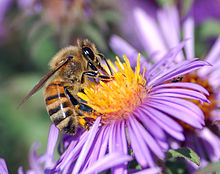
Because they help flowering plants to cross-pollinate, some insects are critical to agriculture. This European honey bee is gathering nectar while pollen collects on its body.
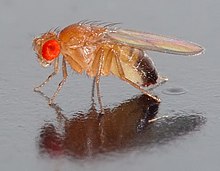
The common fruitfly Drosophila melanogaster is one of the most widely used organisms in biological research.

A robberfly with its prey, a hoverfly. Insectivorous relationships such as these help control insect populations.
Many insects, especially beetles, are scavengers that feed on dead animals and fallen trees and thereby recycle biological materials into forms found useful by other organisms. Insects are responsible for much of the process by which topsoil is created.[9]:3, 218–228 The ancient Egyptian religion considered dung beetles sacred, and represented them as beetle-shaped amulets, or scarabs. Dung beetles have been used in countries including Australia as an agent of biological pest control to reduce the populations of pestilent flies and parasitic worms. The Australian Dung Beetle Project successfully introduced 23 species of dung beetle, including Onthophagus gazella and Euoniticellus intermedius from South Africa and Europe. This resulting in a 90% reduction in bush flies as well as improved soil fertility and quality.[87]
Insects are also used in medicine, for example fly larvae (maggots) were formerly used to treat wounds to prevent or stop gangrene, as they would only consume dead flesh. This treatment is finding modern usage in some hospitals. Adult insects, such as crickets, and insect larvae of various kinds are also commonly used as fishing bait.[88]
Entomophagy
Main article: Entomophagy
In some parts of the world, insects are used for human food, while being a taboo in other places. In some cultures, insects, especially deep-fried cicadas, are considered to be delicacies, while in other places they form part of the normal diet as they have a high protein content for their mass. In most first-world countries, however, entomophagy, or the consumption of insects, is taboo.[89] There are proponents of developing this use to provide a major source of protein in human nutrition.[9]:10–13 Since it is impossible to entirely eliminate pest insects from the human food chain, insects are present in many foods, especially grains. Food safety laws in many countries do not prohibit insect parts in food, but rather limit the quantity. According to cultural materialist anthropologist Marvin Harris, the eating of insects is taboo in cultures that have other protein sources such as fish or livestock.



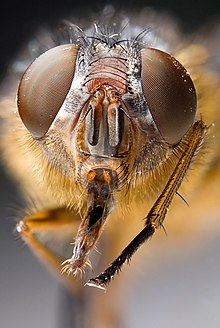

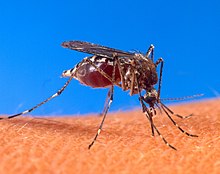
No comments:
Post a Comment